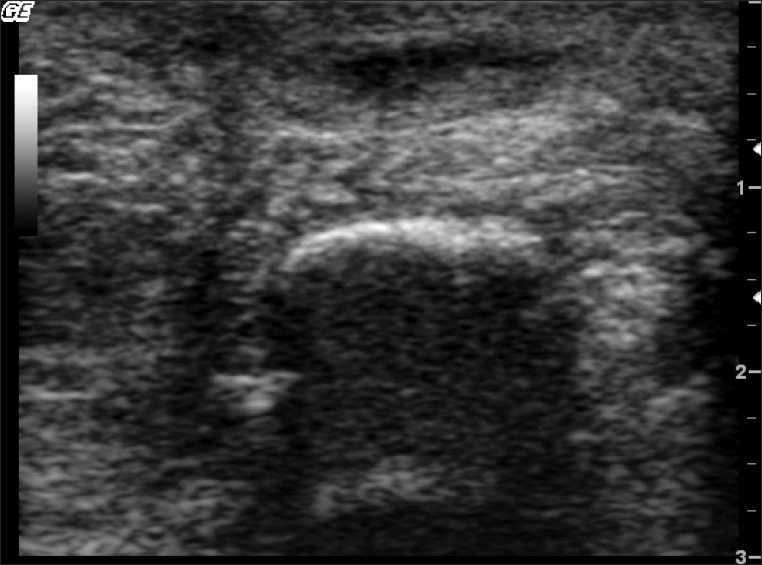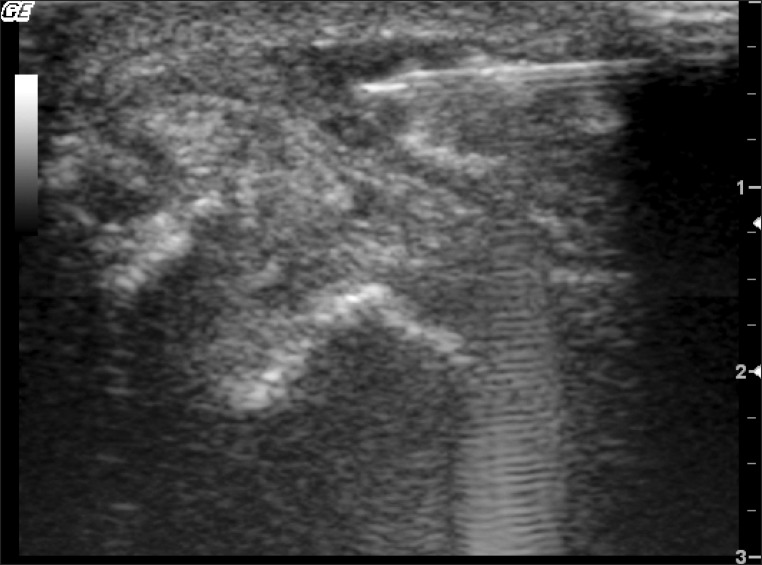Ann Rehabil Med.
2012 Jun;36(3):404-408. 10.5535/arm.2012.36.3.404.
Sonographically Guided Alcohol Injection in Painful Stump Neuroma
- Affiliations
-
- 1Department of Rehabilitation Medicine, Inje University College of Medicine, Ilsanpaik Hospital, Goyang 411-706, Korea. remedios1004@naver.com
- KMID: 2266748
- DOI: http://doi.org/10.5535/arm.2012.36.3.404
Abstract
- Stump neuroma is a common cause of pain from disorganized proliferation of nerve fascicles occurring after limb amputation. Ultrasound guided alcohol injection in painful stump neuroma has been tried as a new treatment approach. Herein, we report 2 male patients, who had traumatic amputation and claimed severe and diffuse burning pain in the stump area. Neuroma at the distal end of an amputated nerve was clearly identified on sonography. The patients gradually developed increasing severe pain that could not be managed with conservative care. They were treated with neurolysis using alcohol solution. Using ultrasonographical guidance, 1.2 ml of 100% dehydrated alcohol was injected into the nerves proximal to neuroma. No complications occurred. The patients were initially pain free. After a few months, however, their stump pain recurred slightly. Repeat neurolysis was performed using 0.3 ml of 100% dehydrated alcohol. During the three months follow-up period, mild stump pain occurred but the patients did not require any analgesics.
Keyword
MeSH Terms
Figure
Cited by 1 articles
-
Treatment of the Traumatic Neuroma
Youn-Tae Roh, Il-Jung Park
J Korean Soc Surg Hand. 2014;19(4):209-220. doi: 10.12790/jkssh.2014.19.4.209.
Reference
-
1. Fischler AH, Gross JB. Ultrasound-guided sciatic neuroma block for treatment of intractable stump pain. J Clin Anesth. 2007; 19:626–628. PMID: 18083479.
Article2. Ernberg LA, Adler RS, Lane J. Ultrasound in the detection and treatment of a painful stump neuroma. Skeletal Radiol. 2003; 32:306–309. PMID: 12719933.
Article3. Gruber H, Kovacs P, Peer S, Frischhut B, Bodner G. Sonographically guided phenol injection in painful stump neuroma. AJR. 2004; 182:952–954. PMID: 15039170.
Article4. Fanucci E, Masala S, Fabiano S, Perugia D, Squillaci E, Varrucciu V, Simonetti G. Treatment of intermetatarsal Morton's neuroma with alcohol injection under US guide: 10-month follow-up. Eur Radiol. 2004; 14:514–518. PMID: 14531002.
Article5. Hughes RJ, Ali K, Jones H, Kendall S, Connell DA. Treatment of Morton's neuroma with alcohol injection under sonographic guidance: follow-up of 101 cases. AJR. 2007; 188:1535–1539. PMID: 17515373.
Article6. Hyer CF, Mehl LR, Block AJ, Vancourt RB. Treatment of recalcitrant intermetatarsal neuroma with 4% sclerosing alcohol injection: a pilot study. J Foot Ankle Surg. 2005; 44:287–291. PMID: 16012436.
Article7. Lewin-Kowalik J, Marcol W, Kotulska K, Mandera M, Klimczak A. Prevention and management of painful neuroma. Neurol Med Chir (Tokyo). 2006; 46:62–67. PMID: 16498214.
Article8. Thomas AJ, Bull MJ, Howard AC, Saleh M. Peri operative ultrasound guided needle localisation of amputation stump neuroma. Injury. 1999; 30:689–691. PMID: 10707244.
Article9. Lin EE, Horasek S, Agarwal S, Wu CL, Raja SN. Local administration of norepinephrine in the stump evokes dose-dependent pain in amputees. Clin J Pain. 2006; 22:482–486. PMID: 16772803.
Article10. Valle M, Zamorani MP. Bianchi S, Martinoli C, editors. Nerve and vessels. Ultrasound of the musculoskeletal system. 2007. 1st ed. New York: Springer-Verlag;p. 97–122.
- Full Text Links
- Actions
-
Cited
- CITED
-
- Close
- Share
- Similar articles
-
- Treatment of Painful Amputation Neuromas
- Treatment of Recurrent Neuroma after Forearm Amputation: End to End Neurorrhaphy
- Outcomes of Ultrasound-Guided Extracorporeal Shock Wave Therapy for Painful Stump Neuroma
- A Case of Thigh Stump Pain with Unidentified Complaints
- Spinal cord stimulation for the treatment of intractable stump pain after amputation of the both lower limbs 36 years ago: A case report





